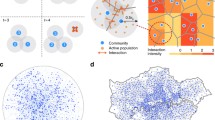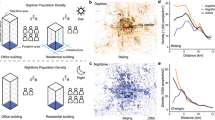Abstract
Many urban phenomena exhibit remarkable regularity in the form of nonlinear scaling behaviors, but their implications on a system of networked cities has never been investigated. Such knowledge is crucial for our ability to harness the complexity of urban processes to further sustainability science. In this paper, we develop a dynamical modeling framework that embeds population–resource dynamics—a generalized Lotka–Volterra system with modifications to incorporate the urban scaling behaviors—in complex networks in which cities may be linked to the resources of other cities and people may migrate in pursuit of higher welfare. We find that isolated cities (i.e., no migration) are susceptible to collapse if they do not have access to adequate resources. Links to other cities may help cities that would otherwise collapse due to insufficient resources. The effects of inter-city links, however, can vary due to the interplay between the nonlinear scaling behaviors and network structure. The long-term population level of a city is, in many settings, largely a function of the city’s access to resources over which the city has little or no competition. Nonetheless, careful investigation of dynamics is required to gain mechanistic understanding of a particular city–resource network because cities and resources may collapse and the scaling behaviors may influence the effects of inter-city links, thereby distorting what topological metrics really measure.






Similar content being viewed by others
References
Alves, L. G. A., Ribeiro, H. V., Lenzi, E. K., & Mendes, R. S. (2013a). Distance to the scaling law: a useful approach for unveiling relationships between crime and urban metrics. PLoS ONE, 8(8), e69580. doi:10.1371/journal.pone.0069580. http://dx.doi.org/10.1371/journal.pone.0069580.
Alves, L. G. A., Ribeiro, H. V., & Mendes, R. S. (2013b). Scaling laws in the dynamics of crime growth rate. Physica A, 392(11), 2672–2679. doi:10.1016/j.physa.2013.02.002. http://dx.doi.org/10.1016/j.physa.2013.02.002.
Barrat, A., Barthélemy, M., & Vespignani, A. (2013). Dynamical processes on complex networks. Cambridge: Cambridge University Press.
Batty, M. (1995). Fractals—new ways of looking at cities. Nature, 377(6550), 574.
Batty, M. (2008). The size, scale, and shape of cities. Science, 319(5864), 769–771. doi:10.1126/science.1151419.
Bettencourt, L. M. A. (2013). The origins of scaling in cities. Science, 340, 1438–1441. doi:10.1126/science.1235823.
Bettencourt, L. M. A., Lobo, J., Helbing, D., Kühnert, C., & West, G. B. (2007). Growth, innovation, scaling, and the pace of life in cities. Proc. Natl. Acad. Sci. USA, 104(17), 7301–7306. doi:10.1073/pnas.0610172104.
Bettencourt, L. M. A., Lobo, J., Strumsky, D., & West, G. B. (2010). Urban scaling and its deviations: revealing the structure of wealth, innovation and crime across cities. PLoS ONE, 5(11), e13541.
Bulkeley, H., & Betsill, M. M. (2003). Cities and climate change: urban sustainability and global environmental governance. London: Routledge.
Castles, S. (2002). Migration and community formation under conditions of globalization. Int. Migr. Rev., 36, 1143–1168.
Colizza, V., Barrat, A., Barthélemy, M., & Vespignani, A. (2006). The role of the airline transportation network in the prediction and predictability of global epidemics. Proc. Natl. Acad. Sci. USA, 103(7), 2015–2020.
Colunga-Garcia, M., Haack, R., & Adelaja, A. (2009). Freight transportation and the potential for invasions of exotic insects in urban and periurban forests of the united states. J. Econ. Entomol., 102(1), 237–246.
D’Odorico, P., Laio, F., & Ridolfi, L. (2010). Does globalization of water reduce societal resilience to drought? Geophys. Res. Lett., 37, L13403. doi:10.1029/2010GL043167.
Fragkias, M., Lobo, J., Strumsky, D., & Seto, K. C. (2013). Does size matter? Scaling of CO2 emissions and U.S. urban areas. PLoS ONE, 8(6), e64727. doi:10.1371/journal.pone.0064727.
Gomez-Lievano, A., Youn, H., & Bettencourt, L. M. A. (2012). The statistics of urban scaling and their connection to Zipf’s law. PLoS ONE, 7(7), e40393.
Kates, R. W., & Parris, T. M. (2003). Long-term trends and a sustainability transition. Proc. Natl. Acad. Sci., 100(14), 8062–8067. doi:10.1073/pnas.1231331100. http://dx.doi.org/10.1073/pnas.1231331100.
Lenzen, M., Moran, D., Kanemoto, K., Foran, B., Lobefaro, L., & Geschke, A. (2012). International trade drives biodiversity threats in developing nations. Nature, 486(7401), 109–112. doi:10.1038/nature11145.
Lobo, J., & Strumsky, D. (2008). Metropolitan patenting, inventor agglomeration and social networks: a tale of two effects. J. Urban Econ., 63(3), 871–884. doi:10.1016/j.jue.2007.07.005.
Lobo, J., Bettencourt, L. M. A., Strumsky, D., & West, G. B. (2013). Urban scaling and the production function for cities. PLoS ONE, 8(3), e58407.
Muneepeerakul, R., & Qubbaj, M. (2012). The effect of scaling and connection on the sustainability of a socio-economic resource system. Ecol. Econ., 77, 123–128. doi:10.1016/j.ecolecon.2012.02.017.
Neal, Z. P. (2011). Differentiating centrality and power in the world city network. Urban Stud., 48(13), 2733–2748.
Neal, Z. P. (2013). The connected city: how networks are shaping the modern metropolis. London: Routledge.
Pickett, S. T. A., Cadenasso, M. L., Grove, J. M., Nilon, C. H., Pouyat, R. V., Zipperer, W. C., & Costanza, R. (2008). Urban ecological systems: linking terrestrial ecological, physical, and socioeconomic components of metropolitan areas urban ecology (pp. 99–122). New York: Springer.
Rees, W., & Wackernagel, M. (1996). Urban ecological footprints: why cities cannot be sustainable (and why they are key to sustainability). Environ. Impact. Asses. Rev., 16, 223–248.
Romer, P. M. (1994). The origins of endogenous growth. J. Econ. Perspect., 8(1), 3–22.
Samet, R. H. (2013). Complexity, the science of cities and long-range futures. Futures, 47, 49–58.
Seto, K. C., Sánchez-Rodríguez, R., & Fragkias, M. (2010). The new geography of contemporary urbanization and the environment. Annu. Rev. Environ. Resour., 35(1), 167.
Trombulak, S. C., & Frissell, C. A. (2000). Review of ecological effects of roads on terrestrial and aquatic communities. Conserv. Biol., 14(1), 18–30.
United Nations Population Fund (UNFPA) (2007). State of world population 2007: Unleashing the potential of urban growth. http://unfpa.org/swp/swpmain.htm.
van den Bergh, J. C. J. M., & Verbruggen, H. (1999). Spatial sustainability, trade and indicators: an evaluation of the “ecological footprint”. Ecol. Econ., 29(1), 61–72.
Vanderheiden, S. (2008). Two conceptions of sustainability. Polit. Stud., 56(2), 435–455.
Wasserman, S., & Faust, K. (1994). Social network analysis: methods and applications. structural analysis in the social sciences. New York: Cambridge University Press.
Wolf, S. R. (2007). Shifting tides: migration in the era of globalization, global conflict, and environmental collapse. Forum on Public Policy: A Journal of the Oxford Round Table. http://forumonpublicpolicy.com/archivesum07/wolf.pdf.
Yamamoto, A. T., & Nadaraja, M. (2006). Urban crisis: culture and the sustainability of cities. United Nations University
Young, R. F. (2009). Interdisciplinary foundations of urban ecology. Urban Ecosyst., 12, 311–331.
Acknowledgements
The authors wish to thank two reviewers for their useful comments. M.R.Q. and R.M. also acknowledge the support from NSF grant GEO-1115054.
Author information
Authors and Affiliations
Corresponding author
Rights and permissions
About this article
Cite this article
Qubbaj, M.R., Shutters, S.T. & Muneepeerakul, R. Living in a Network of Scaling Cities and Finite Resources. Bull Math Biol 77, 390–407 (2015). https://doi.org/10.1007/s11538-014-9949-3
Received:
Accepted:
Published:
Issue Date:
DOI: https://doi.org/10.1007/s11538-014-9949-3




